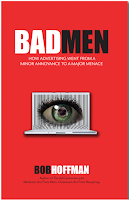Unless you've been involved in making a movie, it is impossible to understand how it can take two years and tens -- if not hundreds -- of millions of dollars. There is simply no way to adequately describe the painstaking intricacies of the process to someone who has never been through it.
To a lesser degree, the same is true in advertising. Clients really have no idea how long it takes and how much work is involved in developing advertising. And when we describe it, it doesn't seem all that complex or difficult. Once again, you have to live through it to understand it.
One of the most successful ad campaigns I've ever done had a little to do with the idea and a lot to do with the casting of the main character. My partner, our producer and I spent four 14 hour days locked in a casting studio in Los Angeles looking for the right person. Luckily, we found him. The campaign was a huge success. But if we had told the client in advance that the casting alone would cost tens of thousands of dollars in man-hours, they would have fired us.
Conversely, one of the most disastrous campaigns I've ever done was also casting-related. The key character we wanted for the campaign (Edie McClurg - see below) was booked on the day of the shoot and the client wouldn't let us move the shoot back a day. We had to book someone else and it ruined the entire campaign and almost cost us the account.
My point here is not about casting, it's about the amount of invisible, unexplainable time and work that goes into doing advertising right.
Consequently, one of the problems that an ad agency is always facing is how to justify our costs and fees to our clients when they don't really understand how much time and work goes into what we do.
One of the primary weapons that we use to compensate for this is to make the process of developing strategy mysterious. The logic goes like this -- we'll never get them to understand how painstaking the creative process is, but we can make it up on the front end by making the strategy development process seem as complicated and arcane as possible. This is not necessarily willful deception, it's just baked into the rituals of the ad business.
And so we have planners doing ethnographic this and anthropological that, and we have directors of cognitive studies and brand architects and all manner of abstruse nonsense to make the practice of developing strategies seem scientific, mysterious and worth all the money we charge.
My favorite story in this regard relates to one of America's most famous and successful ad agencies, which for reasons of discretion I will not name. A couple of years ago it won a very prestigious award for account planning on a very successful ad campaign. One of my colleagues congratulated the creative director on the account, a friend of his, for the award. The creative director laughed. "Why are you laughing?" asked my colleague. "I never had a single conversation with the planner," replied his friend.
Nonetheless, the the more magical we can make the strategic process seem, the more we are worth because we are the ones who can interpret all the mysterious goings-on of the consumer's mind.
For the most part, this is nonsense. Probably ninety percent of consumer behavior is perfectly obvious. People buy most stuff because it tastes better, looks nicer, works better, or is cheaper or more convenient.
Yes, perhaps 10 to 15% of consumer behavior is truly mysterious, but unless you are in the fashion, soft drink, cigarette or alcoholic beverage business, you'd be well-served to just ignore it.
Although the traditional ad industry has always been pretty good at the game of creating misdirection, they are mere children compared with the online ad industry. They have taken blinding clients with science to new, unimaginable heights.
While the online ad industry has developed all kinds of mysterious math to confound the uninitiated, the big picture is pretty obvious. Every now and then I write about the dismal data, e.g. Facebook ad click-through rates under 5 in ten thousand; general display ads with average click-through rates of one in a thousand.
Each time I quote these facts I get angry emails and comments saying, "oh yeah, well no one ever clicked on a newspaper or magazine ad."
If the point is that online display ads are about as effective as similar small space print ads, all I can say is, I couldn't agree more.
Here is the above-mentioned Edie McClurg in a scene with Steve Martin from "Planes, Trains, and Automobiles"
Subscribe to:
Post Comments (Atom)





No comments:
Post a Comment